|
|
#1001 |
|
⊙▃⊙
|
Daily Suspicious0bserver's Weather Post:
July 26, 2014 What's in the sky tonight? July 26, 2014 -New Moon (exact at 6:42 p.m. EDT). Summer is hardly more than a third over, astronomically speaking. But already the Great Square of Pegasus, symbol of the coming fall, heaves up from behind the east-northeast horizon at dusk and climbs higher in the east through the evening. It's balancing on one corner. -The return of old sunspots AR2107 and AR2108 from the farside of the sun has failed to elevate solar activity. The two formerly-active regions decayed during their two week absence and are now little more than "sunspot corpses." Forecasters expect the quiet sun to remain quiet throughout the weekend. -Auroras were *not* in the forecast this weekend. Nevertheless, "they're baaaaaaack," reports Bob Conzemius, who saw the Northern Lights on July 26th over Grand Rapids, Minnesota: "It has been a pretty quiet summer in northern Minnesota for seeing auroras, so it was nice to see them again," says Conzemius. "I shot entirely within the city limits of Grand Rapids, starting from my front yard and ending at McKinney Lake as it was getting light at 4:00 AM CDT." The source of this unexpected display was a fluctuation in the interplanetary magnetic field. The IMF tipped south, opening a crack in Earth's magnetospere. Solar wind poured in and ignited the auroras. 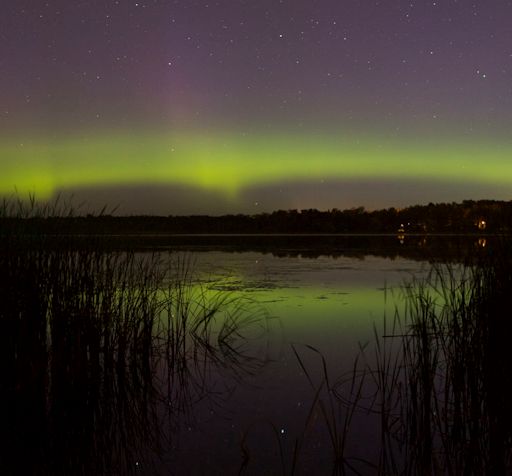 Astro Picture of the Day: July 26, 2014 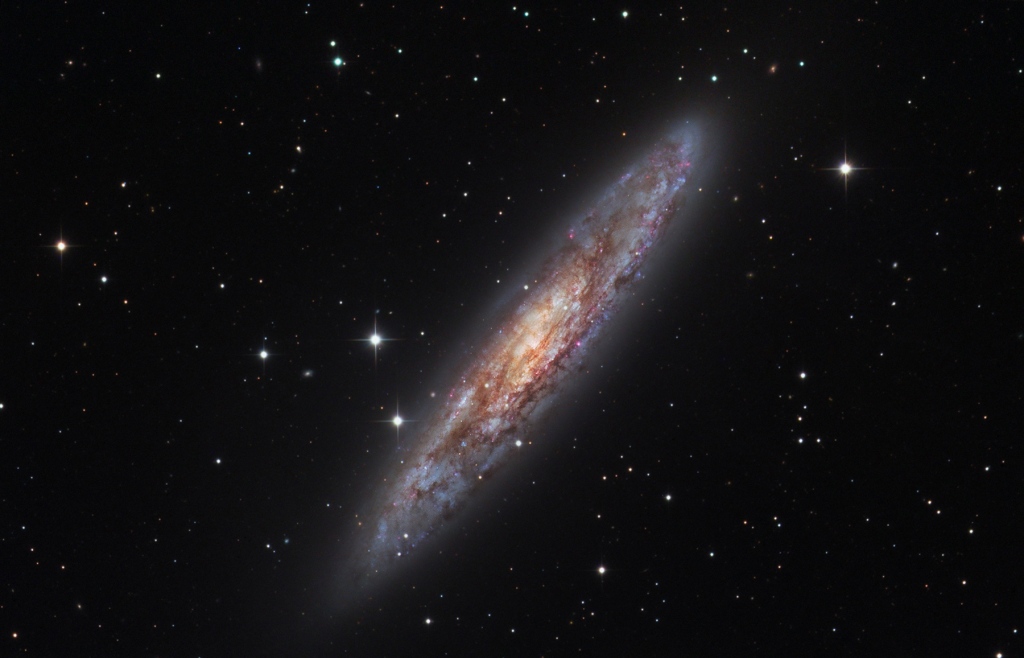 Shiny NGC 253 is one of the brightest spiral galaxies visible, and also one of the dustiest. Some call it the Silver Dollar Galaxy for its appearance in small telescopes, or just the Sculptor Galaxy for its location within the boundaries of the southern constellation Sculptor. First swept up in 1783 by mathematician and astronomer Caroline Herschel, the dusty island universe lies a mere 10 million light-years away. About 70 thousand light-years across, NGC 253 is the largest member of the Sculptor Group of Galaxies, the nearest to our own Local Group of Galaxies. In addition to its spiral dust lanes, tendrils of dust seem to be rising from a galactic disk laced with young star clusters and star forming regions in this sharp color image. The high dust content accompanies frantic star formation, earning NGC 253 the designation of a starburst galaxy. NGC 253 is also known to be a strong source of high-energy x-rays and gamma rays, likely due to massives black hole near the galaxy's center.
__________________
1st in Kommisar's 2009 SM Tournament 1st in I Love You`s 2009 New Year`s Tournament 3rd in EnR's Mashfest '08 tournament 5th in Phynx's Unofficial FFR Tournament 9th in D3 of the 2008-2009 4th Official FFR Tournament 10th in D5 of the 2010 5th Official FFR Tournament 10th in D6 of the 2011-2012 6th Official FFR Tournament FMO AAA Count: 71 FGO AAA Count: 10 Bluearrowll = The Canadian player who can not detect awkward patterns. If it's awkward for most people, it's normal for Terry. If the file is difficult but super straight forward, he has issues. If he's AAAing a FGO but then heard that his favorite Hockey team was losing by a point, Hockey > FFR PS: Cool AAA's Terry - I Love You An Alarm Clock's Haiku beep beep beep beep beep beep beep beep beep beep beep beep beep beep beep beep beep - ieatyourlvllol |
|
|

|
|
|
#1002 |
|
⊙▃⊙
|
Daily Suspicious0bserver's Weather Post:
July 27, 2014 What's in the sky tonight? July 27, 2014 -Despite an uptick in the sunspot number, solar activity remains low. AR2121 has a 'beta-gamma' magnetic field that harbors energy for M-class solar flares, but so far the quiet sunspot seems dis-inclined to erupt. A significant flare this weekend would be a surprise. -What a difference 10 years can make. The Solar Max of 2014 has been mild, producing relatively few sunspots and meagre auroras. A decade ago, however, a much more potent Solar Max was underway. A strong solar storm on July 27, 2004, sparked Northern Lights as far south as the Anza-Borrego Desert of California. Photographer Dennis Mammana recalls the night: "It was ten years ago--during the pre-dawn hours of July 27, 2004--that the Anza-Borrego Desert of Southern California was bathed in the most unusual of light—that of the aurora borealis. On this morning it danced over so wide an area of the northern sky that it required four wide-angle images stitched carefully together to capture it all." "As the sky darkened the night before, solar data convinced me that we in the Desert Southwest might get a rare display of Northern Lights, so I aimed a camera north and set it to take one exposure every minute. From time to time I checked the camera's LCD screen to see if it had captured anything of interest. Then, just before 4 a.m., I discovered blue streaks across the image. 'What a lousy time for the sensor to crap out on me!', I thought. But as I scrolled through the previous images to learn where it went bad, I saw the blue streaks dancing gracefully across the scene. It was the Northern Lights!" "I hastily threw all my gear in the back of the Jeep and headed for an interesting foreground a couple of miles away. And the photo you see is the result--perhaps the only image of the northern lights with ocotillos in the foreground!" Mammana's recollection reminds us what a "good Solar Max" is really like. There is still hope, however, that the ongoing mini-Max might produce some good displays. Statistics of previous solar cycles show that the strongest geomagnetic storms tend to occur during the declining phase of solar cycles--in other words, just where we are now. There may yet be SoCal auroras in the offing before this Solar Max is done. Astro Picture of the Day: July 27, 2014 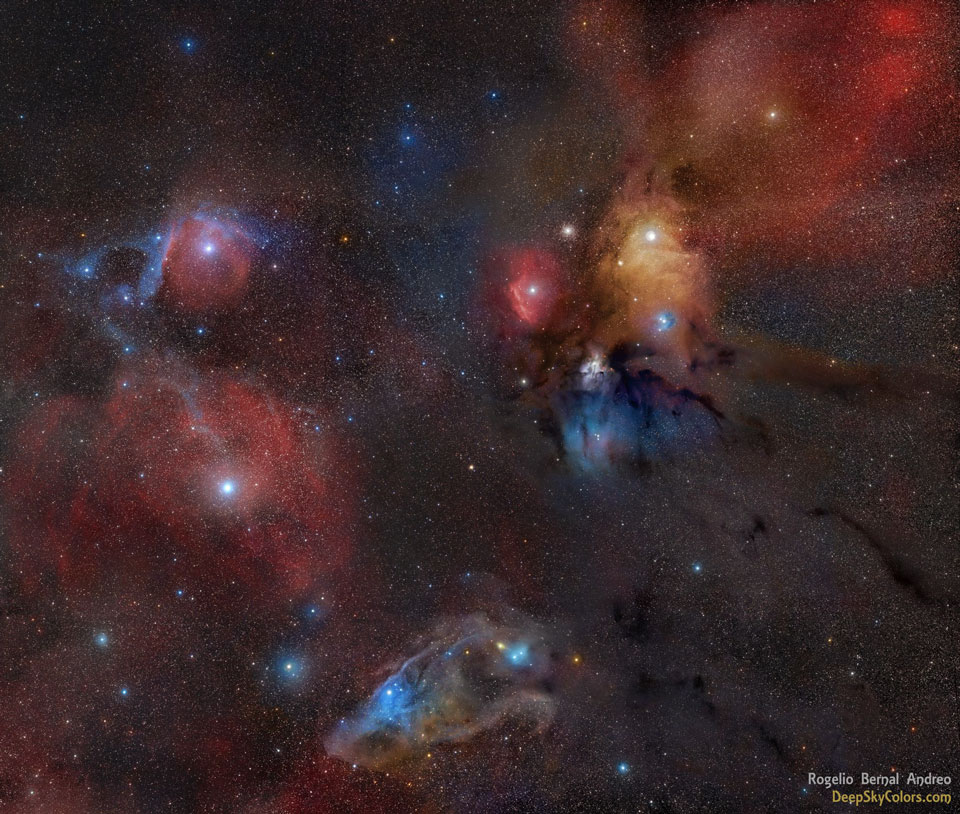 The clouds surrounding the star system Rho Ophiuchi compose one of the closest star forming regions. Rho Ophiuchi itself is a binary star system visible in the light-colored region on the image right. The star system, located only 400 light years away, is distinguished by its colorful surroundings, which include a red emission nebula and numerous light and dark brown dust lanes. Near the upper right of the Rho Ophiuchi molecular cloud system is the yellow star Antares, while a distant but coincidently-superposed globular cluster of stars, M4, is visible between Antares and the red emission nebula. Near the image bottom lies IC 4592, the Blue Horsehead nebula. The blue glow that surrounds the Blue Horsehead's eye -- and other stars around the image -- is a reflection nebula composed of fine dust. On the above image left is a geometrically angled reflection nebula cataloged as Sharpless 1. Here, the bright star near the dust vortex creates the light of surrounding reflection nebula. Although most of these features are visible through a small telescope pointed toward the constellations of Ophiuchus, Scorpius, and Sagittarius, the only way to see the intricate details of the dust swirls, as featured above, is to use a long exposure camera.
__________________
1st in Kommisar's 2009 SM Tournament 1st in I Love You`s 2009 New Year`s Tournament 3rd in EnR's Mashfest '08 tournament 5th in Phynx's Unofficial FFR Tournament 9th in D3 of the 2008-2009 4th Official FFR Tournament 10th in D5 of the 2010 5th Official FFR Tournament 10th in D6 of the 2011-2012 6th Official FFR Tournament FMO AAA Count: 71 FGO AAA Count: 10 Bluearrowll = The Canadian player who can not detect awkward patterns. If it's awkward for most people, it's normal for Terry. If the file is difficult but super straight forward, he has issues. If he's AAAing a FGO but then heard that his favorite Hockey team was losing by a point, Hockey > FFR PS: Cool AAA's Terry - I Love You An Alarm Clock's Haiku beep beep beep beep beep beep beep beep beep beep beep beep beep beep beep beep beep - ieatyourlvllol |
|
|

|
|
|
#1003 |
|
⊙▃⊙
|
Daily Suspicious0bserver's Weather Post:
July 28, 2014 What's in the sky tonight? July 28, 2014 -Mars continues its eastward trek against the cosmic backdrop. Look southwest at dusk. You'll notice that it's now definitely closer to Saturn than Antares is. Mars is to Saturn's lower right; Antares is to Saturn's lower left. -NOAA forecasters estimate a 20% chance of polar geomagnetic storms today when Earth makes contact with a minor solar wind stream. Sky watchers around the darkening Arctic Circle should be alert for auroras. -Earth is entering a broad stream of debris from Comet Swift-Tuttle, source of the annual Perseid meteor shower. Although the peak of the shower is not expected until August, meteors are already flitting acrosss the night sky. On July 27th, NASA cameras caught this Perseid fireball flying over New Mexico. Over the weekend, NASA detected a total of five Perseid fireballs, a "micro-flurry" that signals the beginning of the annual display. Normally the best time to watch would be during the shower's peak: August 11th through 13th. This year, however, the supermoon will cast an interfering glare across the nights of maximum activity, reducing visibility from 120 meteors per hour (the typical Perseid peak rate) to less than 30. Instead, late July-early August might be the best time to watch as Earth plunges deeper into the debris stream before the Moon becomes full. If you go out meteor watching in the nights ahead, you'll likely see another shower, too: the Southern Delta Aquariids. Produced by debris from Comet 96P/Machholz, this shower peaks on July 29-30 with 15 to 20 meteors per hour. This is considered to be a minor shower, but rich enough in fireballs to merit attention. NASA will stream the display from an observing site at the Marshall Space Flight Center in Alabama. Live video begins on July 29th at 9:30 pm EDT. 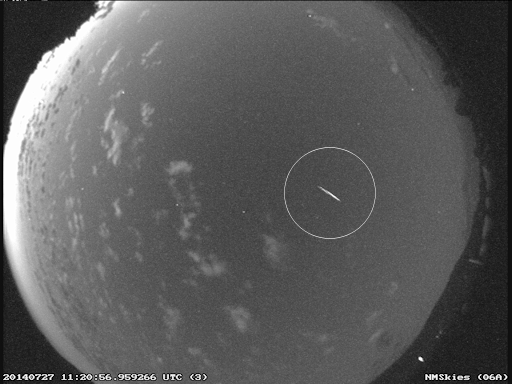 Astro Picture of the Day: July 28, 2014 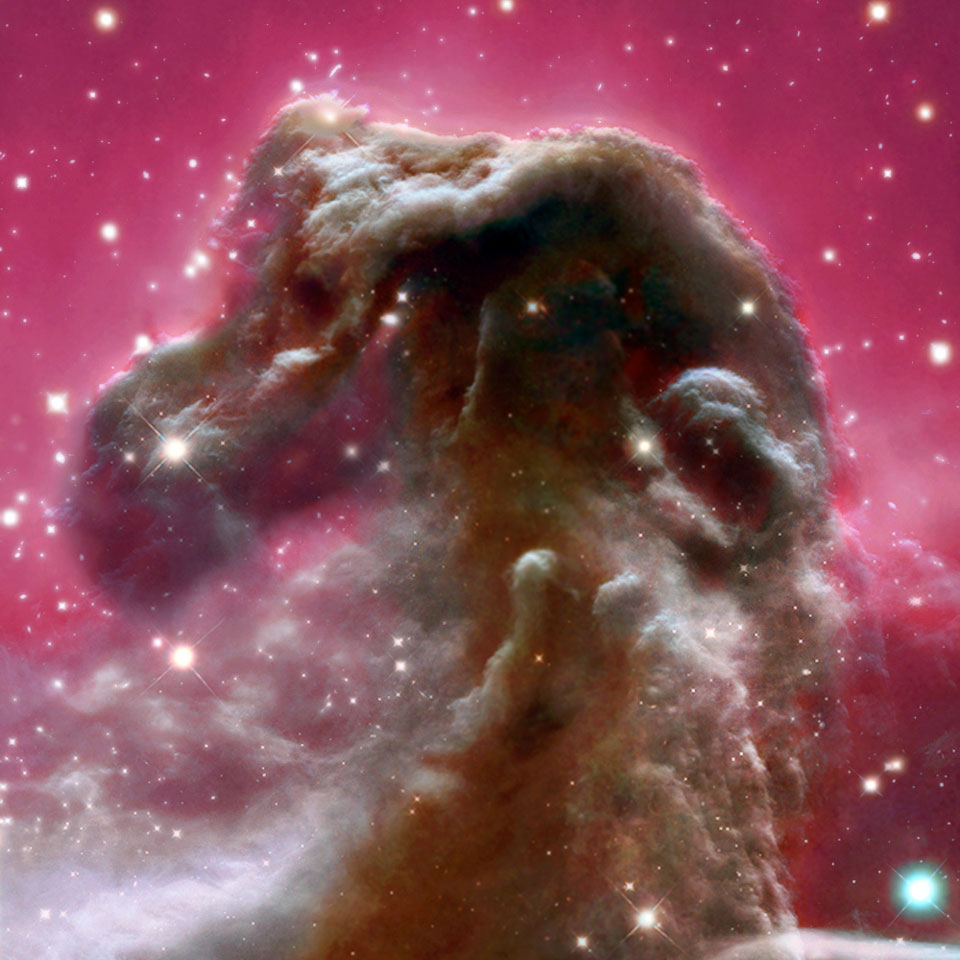 The clouds surrounding the star system Rho Ophiuchi compose one of the One of the most identifiable nebulae in the sky, the Horsehead Nebula in Orion, is part of a large, dark, molecular cloud. Also known as Barnard 33, the unusual shape was first discovered on a photographic plate in the late 1800s. The red glow originates from hydrogen gas predominantly behind the nebula, ionized by the nearby bright star Sigma Orionis. The darkness of the Horsehead is caused mostly by thick dust, although the lower part of the Horsehead's neck casts a shadow to the left. Streams of gas leaving the nebula are funneled by a strong magnetic field. Bright spots in the Horsehead Nebula's base are young stars just in the process of forming. Light takes about 1,500 years to reach us from the Horsehead Nebula. The above image is a digital combination of images taken in blue, green, red, and hydrogen-alpha light from the Argentina, and an image taken in infrared light by the orbiting Hubble Space Telescope.
__________________
1st in Kommisar's 2009 SM Tournament 1st in I Love You`s 2009 New Year`s Tournament 3rd in EnR's Mashfest '08 tournament 5th in Phynx's Unofficial FFR Tournament 9th in D3 of the 2008-2009 4th Official FFR Tournament 10th in D5 of the 2010 5th Official FFR Tournament 10th in D6 of the 2011-2012 6th Official FFR Tournament FMO AAA Count: 71 FGO AAA Count: 10 Bluearrowll = The Canadian player who can not detect awkward patterns. If it's awkward for most people, it's normal for Terry. If the file is difficult but super straight forward, he has issues. If he's AAAing a FGO but then heard that his favorite Hockey team was losing by a point, Hockey > FFR PS: Cool AAA's Terry - I Love You An Alarm Clock's Haiku beep beep beep beep beep beep beep beep beep beep beep beep beep beep beep beep beep - ieatyourlvllol |
|
|

|
|
|
#1004 |
|
⊙▃⊙
|
Daily Suspicious0bserver's Weather Post:
July 29, 2014 What's in the sky tonight? July 29, 2014 -Vega is the brightest star very high in the east. Far down to its lower right shines Altair, almost as bright. Altair is flagged by little Tarazed (3rd magnitude) a finger-width above it, an orange giant far in Altair's background. -The European Space Agency's Rosetta spacecraft is now less than 2300 km from Comet 67P/Churyumov-Gerasimenko. In only 9 days, Rosetta will reach the comet's core and go into orbit around it. Latest images from the probe's navigation camera show a strangely-shaped nucleus that is coming into sharper focus day by day.  Astro Picture of the Day: July 29, 2014  To some, it may look like a portal into the distant universe. To others, it may appear as the eye of a giant. Given poetic license, both are correct. Pictured above is a standard fisheye view of the sky -- but with an unusual projection. The view is from a perch in New Zealand called Te Mata Peak, a name that translates from the Maori language as "Sleeping Giant". The wondrous panorama shows the band of our Milky Way Galaxy right down the center of the sky, with the Large and Small Magellanic Clouds visible to the right. The red hue is atmospheric airglow that surprised the photographer as it was better captured by the camera than the eye. The above image was taken two weeks ago as the photographer's sister, on the left, and an acquaintance peered into the sky portal.
__________________
1st in Kommisar's 2009 SM Tournament 1st in I Love You`s 2009 New Year`s Tournament 3rd in EnR's Mashfest '08 tournament 5th in Phynx's Unofficial FFR Tournament 9th in D3 of the 2008-2009 4th Official FFR Tournament 10th in D5 of the 2010 5th Official FFR Tournament 10th in D6 of the 2011-2012 6th Official FFR Tournament FMO AAA Count: 71 FGO AAA Count: 10 Bluearrowll = The Canadian player who can not detect awkward patterns. If it's awkward for most people, it's normal for Terry. If the file is difficult but super straight forward, he has issues. If he's AAAing a FGO but then heard that his favorite Hockey team was losing by a point, Hockey > FFR PS: Cool AAA's Terry - I Love You An Alarm Clock's Haiku beep beep beep beep beep beep beep beep beep beep beep beep beep beep beep beep beep - ieatyourlvllol |
|
|

|
|
|
#1005 |
|
FFR Player
Join Date: Dec 2007
Location: nima
Posts: 4,278
|
cosmic asscrack detected
|
|
|

|
|
|
#1006 |
|
⊙▃⊙
|
Daily Suspicious0bserver's Weather Post:
July 30, 2014 What's in the sky tonight? July 30, 2014 -The two brightest stars of summer are Vega, just east of the zenith after dark, and Arcturus, less high toward the west. Both are zero magnitude. The next zero-magnitude star to make its appearance will be Capella. It doesn't emerge until the early-morning hours. Look for it low in the north-northeast after about 1 a.m. local time (depending on your location, especially your latitude). -As the sunspot number rebounds from a deep low in mid-July, the chance of flares is increasing, too. However, the biggest threat for a flare today might not be a sunspot at all. Instead, our attention turns to a long dark filament of magnetism. Astrophotograher Jack Newton photographed the structure on July 29th from his observatory in Osoyoos, British Columbia. Stretching more than 100,000 km from end to end, and filled with dense plasma, the sinuous filament is held aloft by solar magnetic fields. If it snaps or collapses and hits the stellar surface below, the result could be a Hyder flare--a type of explosion that does not require a sunspot. NOAA forecasters estimate an increasing 25% chance of M-flares and a small but non-negligible 5% chance of X-flares on July 30th. 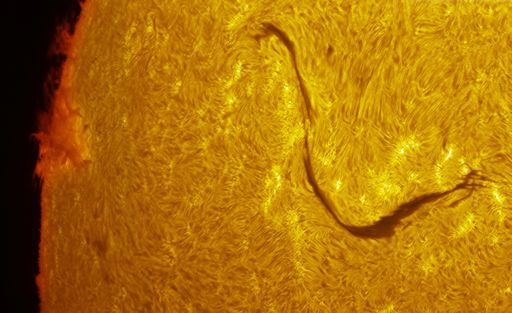 Astro Picture of the Day: July 30, 2014 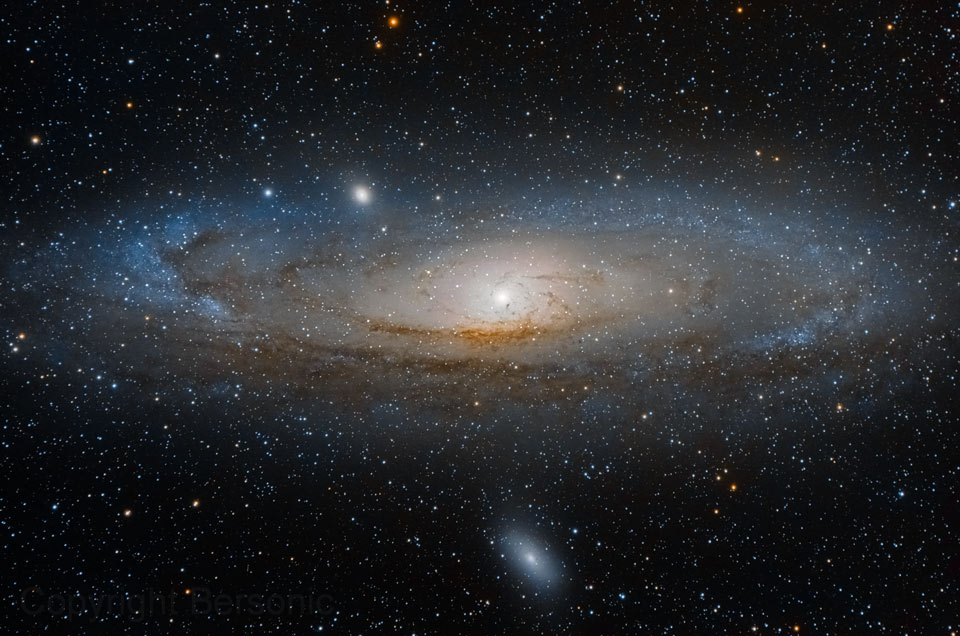 Andromeda is the nearest major galaxy to our own Milky Way Galaxy. Our Galaxy is thought to look much like Andromeda. Together these two galaxies dominate the Local Group of galaxies. The diffuse light from Andromeda is caused by the hundreds of billions of stars that compose it. The several distinct stars that surround Andromeda's image are actually stars in our Galaxy that are well in front of the background object. Andromeda is frequently referred to as M31 since it is the 31st object on Messier's list of diffuse sky objects. M31 is so distant it takes about two million years for light to reach us from there. Although visible without aid, the above image of M31 was taken with a standard camera through a small telescope. Much about M31 remains unknown, including how it acquired its unusual double-peaked center.
__________________
1st in Kommisar's 2009 SM Tournament 1st in I Love You`s 2009 New Year`s Tournament 3rd in EnR's Mashfest '08 tournament 5th in Phynx's Unofficial FFR Tournament 9th in D3 of the 2008-2009 4th Official FFR Tournament 10th in D5 of the 2010 5th Official FFR Tournament 10th in D6 of the 2011-2012 6th Official FFR Tournament FMO AAA Count: 71 FGO AAA Count: 10 Bluearrowll = The Canadian player who can not detect awkward patterns. If it's awkward for most people, it's normal for Terry. If the file is difficult but super straight forward, he has issues. If he's AAAing a FGO but then heard that his favorite Hockey team was losing by a point, Hockey > FFR PS: Cool AAA's Terry - I Love You An Alarm Clock's Haiku beep beep beep beep beep beep beep beep beep beep beep beep beep beep beep beep beep - ieatyourlvllol |
|
|

|
|
|
#1007 |
|
⊙▃⊙
|
Daily Suspicious0bserver's Weather Post:
July 31, 2014 What's in the sky tonight? July 31, 2014 -In a really dark sky, the Milky Way now forms a magnificent arch high across the whole eastern sky after darkness is complete. It runs all the way from below Cassiopeia in the north-northeast, up and across Cygnus and the Summer Triangle high in the east, and down past the spout of the Sagittarius Teapot in the south. -On Oct. 19, 2014, Comet Siding Spring (C/2013 A1) will pass extremely close to Mars. For a while last year researchers thought the comet's core might strike the planet's surface. Now we know that it will be a near miss. Siding Spring will glide by Mars only 132,000 km away--about 1/3rd of the distance between Earth and the Moon. On July 28th, UK astrophotographer Damian Peach photographed the comet en route to Mars passing by the galaxy Fornax A. "This proved to be a rather fascinating conjunction due to the strange appearance of Fornax A," says Peach. "The various faint shells surrounding it are thought to have been caused by several galactic collisions in the remote past." Three months from now the comet will reach Mars. Although the comet's nucleus will not strike the planet, gas and dust spewing out of the comet's core will likely interact with the Martian atmosphere. There could be a meteor shower, auroras, and other effects that no one can predict. NASA's fleet of Mars spacecraft and rovers will record whatever happens. 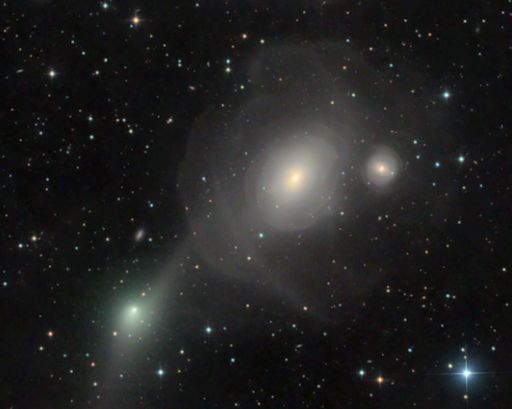 Astro Picture of the Day: July 31, 2014 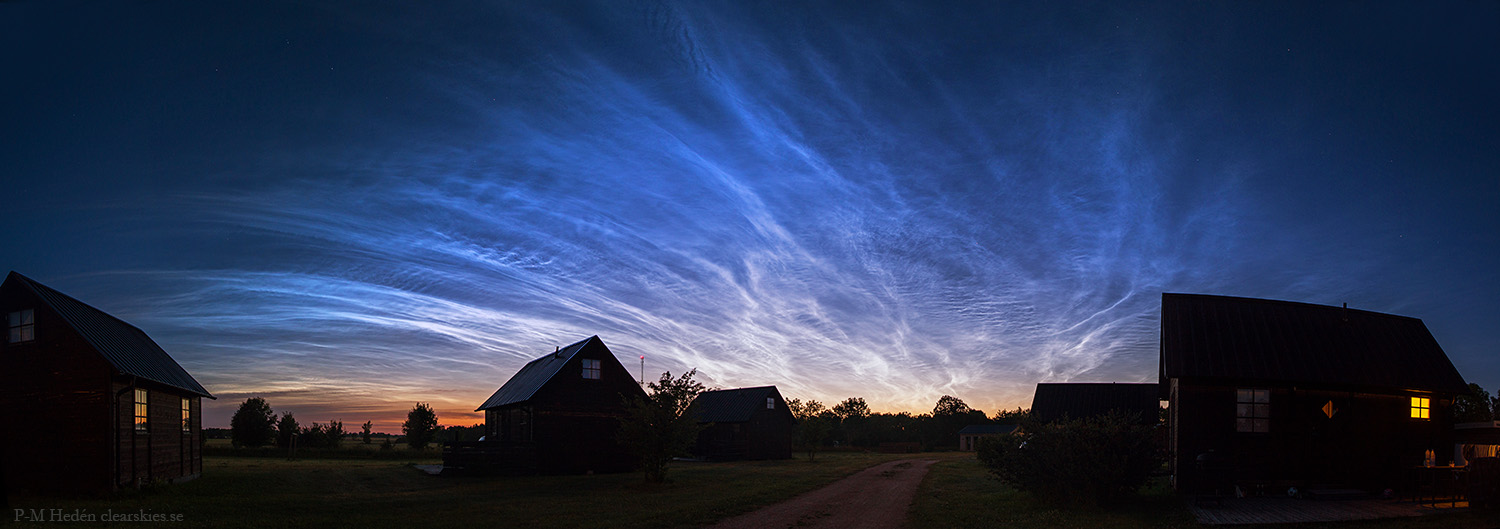 Transfusing sunlight through a a still dark sky, this exceptional display of noctilucent clouds was captured earlier this month above the island of Gotland, Sweden. From the edge of space, about 80 kilometers above Earth's surface, the icy clouds reflect sunlight even though the Sun itself is below the horizon as seen from the ground. Usually spotted at high latitudes in summer months the night shining clouds made a strong showing this July. Also known as polar mesopheric clouds they are understood to form as water vapor driven into the cold upper atmosphere condenses on the fine dust particles supplied by disintegrating meteors or volcanic ash. NASA's AIM mission provides daily projections of noctilucent clouds as seen from space.
__________________
1st in Kommisar's 2009 SM Tournament 1st in I Love You`s 2009 New Year`s Tournament 3rd in EnR's Mashfest '08 tournament 5th in Phynx's Unofficial FFR Tournament 9th in D3 of the 2008-2009 4th Official FFR Tournament 10th in D5 of the 2010 5th Official FFR Tournament 10th in D6 of the 2011-2012 6th Official FFR Tournament FMO AAA Count: 71 FGO AAA Count: 10 Bluearrowll = The Canadian player who can not detect awkward patterns. If it's awkward for most people, it's normal for Terry. If the file is difficult but super straight forward, he has issues. If he's AAAing a FGO but then heard that his favorite Hockey team was losing by a point, Hockey > FFR PS: Cool AAA's Terry - I Love You An Alarm Clock's Haiku beep beep beep beep beep beep beep beep beep beep beep beep beep beep beep beep beep - ieatyourlvllol |
|
|

|
|
|
#1008 |
|
⊙▃⊙
|
Daily Suspicious0bserver's Weather Post:
August 1, 2014 What's in the sky tonight? August 1, 2014 -At dusk this evening, the Moon forms the lower-right end of a very long, curving line of celestial objects. Counting to the Moon's upper left, these are Spica, Mars, and Saturn, as shown here. -Today is Lammas Day or Lughnasadh, one of the four traditional "cross-quarter" days midway between the solstices and equinoxes. More or less. The actual midpoint between the June solstice and the September equinox this year comes at 2:40 a.m. August 7th Eastern Daylight Time (6:40 UT). That will be the exact center of (astronomical) summer. -ESA's Rosetta probe is now only five days away from a historic encounter with Comet 67P/Churyumov-Gerasimenko. If all goes as planned, Rosetta will become the first spacecraft to orbit a comet, follow it around the sun, and even drop a lander on its surface. Readers got a sneak preview yesterday when ESA released dramatic new images of the comet's core and atmosphere. The comet's atmosphere or "coma" (left), is a mixture of gas and dust slowly evaporating away from the sun-warmed core (right). At the moment, the coma is diffuse and relatively calm. That's because the comet is still far from the sun, about 544 million kilometers away in the cold dark space between Mars and Jupiter. A year from now this could change, however, as the comet swings by the sun only 185 million kilometers away. Increased solar heating will liberate jets of dust and high-speed streamers of gas, swelling the coma into something larger and much more dangerous to the spacecraft. Rosetta is meeting up with the comet now so that researchers can not only study how the comet warms up along its orbit and how activity develops, but also because it is much safer to learn how to operate in such a new environment when the activity is relatively low. Moreover, landing would be significantly more challenging next year when activity is expected to be much higher.  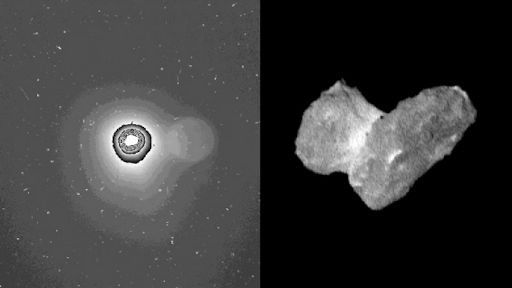 Astro Picture of the Day: August 1, 2014 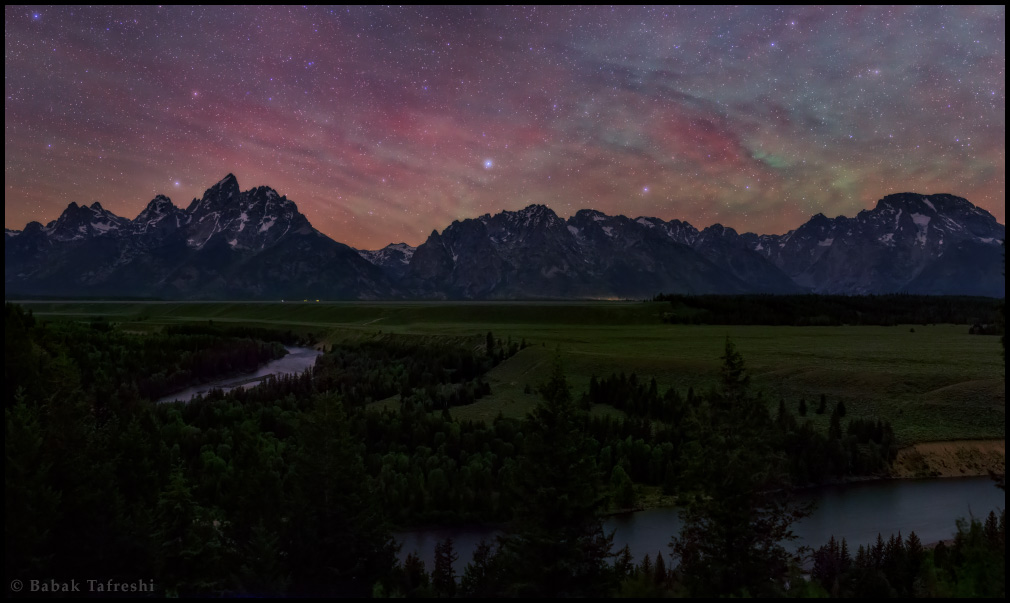 An alluring night skyscape, this scene looks west across the Grand Teton National Park, Wyoming, USA, Planet Earth. The Snake River glides through the foreground, while above the Tetons' rugged mountain peaks the starry sky is laced with exceptionally strong red and green airglow. That night, the luminous atmospheric glow was just faintly visible to the eye, its color and wavey structure captured only by a sensitive digital camera. In fact, this contemporary digital photograph matches the location and perspective of a well-known photograph from 1942 - The Tetons and The Snake River , by Ansel Adams, renown photographer of the American West. Adams' image is one of 115 images stored on the Voyager Golden Record. Humanity's message in a bottle, golden records were onboard both Voyager 1 and Voyager 2 spacecraft, launched in 1977 and now headed toward interstellar space.
__________________
1st in Kommisar's 2009 SM Tournament 1st in I Love You`s 2009 New Year`s Tournament 3rd in EnR's Mashfest '08 tournament 5th in Phynx's Unofficial FFR Tournament 9th in D3 of the 2008-2009 4th Official FFR Tournament 10th in D5 of the 2010 5th Official FFR Tournament 10th in D6 of the 2011-2012 6th Official FFR Tournament FMO AAA Count: 71 FGO AAA Count: 10 Bluearrowll = The Canadian player who can not detect awkward patterns. If it's awkward for most people, it's normal for Terry. If the file is difficult but super straight forward, he has issues. If he's AAAing a FGO but then heard that his favorite Hockey team was losing by a point, Hockey > FFR PS: Cool AAA's Terry - I Love You An Alarm Clock's Haiku beep beep beep beep beep beep beep beep beep beep beep beep beep beep beep beep beep - ieatyourlvllol |
|
|

|
|
|
#1009 |
|
⊙▃⊙
|
Daily Suspicious0bserver's Weather Post:
August 2, 2014 What's in the sky tonight? August 2, 2014 -The Moon shines about midway between Spica and Mars this evening, as shown below (plotted for the middle of North America). -This weekend, Jupiter and Mercury are in conjunction. Don't bother looking because the meeting takes place in the noontime sky. What human eyes cannot see, however, spacecraft can. Using an opaque disk to block the glare of the sun, the Solar and Heliospheric Observatory (SOHO) is monitoring the encounter. At closest approach on August 2nd, the two bright planets will be less than 1o apart. If such an alignment occured at night, it would surely be headline news. At noon, its just spaceweather news.  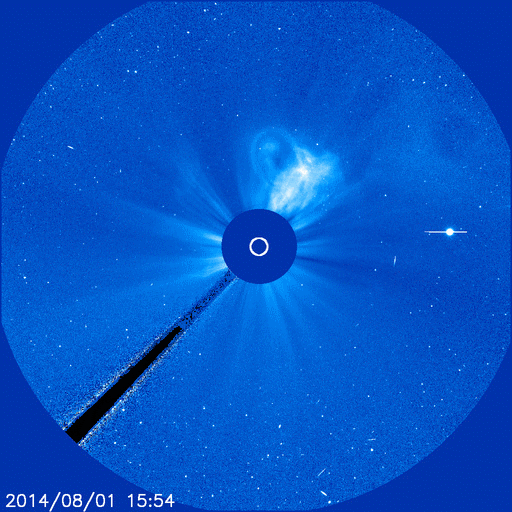 Astro Picture of the Day: August 2, 2014 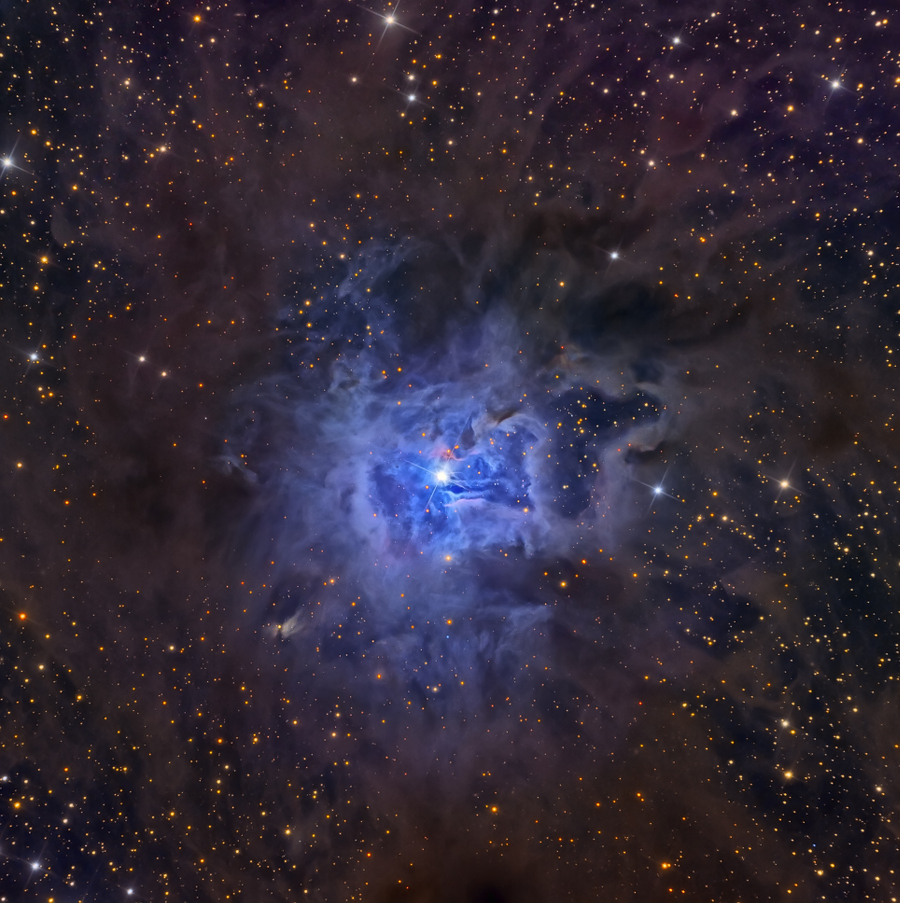 These clouds of interstellar dust and gas have blossomed 1,300 light-years away in the fertile star fields of the constellation Cepheus. Sometimes called the Iris Nebula, NGC 7023 is not the only nebula in the sky to evoke the imagery of flowers, though. Still, this deep telescopic view shows off the Iris Nebula's range of colors and symmetries in impressive detail. Within the Iris, dusty nebular material surrounds a hot, young star. The dominant color of the brighter reflection nebula is blue, characteristic of dust grains reflecting starlight. Central filaments of the dusty clouds glow with a faint reddish photoluminesence as some dust grains effectively convert the star's invisible ultraviolet radiation to visible red light. Infrared observations indicate that this nebula may contain complex carbon molecules known as PAHs. The pretty blue petals of the Iris Nebula span about six light-years.
__________________
1st in Kommisar's 2009 SM Tournament 1st in I Love You`s 2009 New Year`s Tournament 3rd in EnR's Mashfest '08 tournament 5th in Phynx's Unofficial FFR Tournament 9th in D3 of the 2008-2009 4th Official FFR Tournament 10th in D5 of the 2010 5th Official FFR Tournament 10th in D6 of the 2011-2012 6th Official FFR Tournament FMO AAA Count: 71 FGO AAA Count: 10 Bluearrowll = The Canadian player who can not detect awkward patterns. If it's awkward for most people, it's normal for Terry. If the file is difficult but super straight forward, he has issues. If he's AAAing a FGO but then heard that his favorite Hockey team was losing by a point, Hockey > FFR PS: Cool AAA's Terry - I Love You An Alarm Clock's Haiku beep beep beep beep beep beep beep beep beep beep beep beep beep beep beep beep beep - ieatyourlvllol |
|
|

|
|
|
#1010 |
|
⊙▃⊙
|
Daily Suspicious0bserver's Weather Post:
August 3, 2014 What's in the sky tonight? August 3, 2014 -This weekend the ESA released a new image of Comet 67P/Churyumov-Gerasimenko as seen from the Rosetta probe only 1000 km away. It shows the rough surface of the comet's double nucleus in amazing detail: The photo was taken on Aug. 1st at 02:48 UTC by Rosetta's OSIRIS Narrow Angle Camera. The dark spot near image-center is an artifact from the onboard CCD. This new view heightens anticipation for August 6th when Rosetta reaches the comet and goes into orbit around it. Then we will see the strange double-core from point-blank range, and researchers can start to pick touchdown sites for Philae, a lander that will descend to the comet's surface in November.  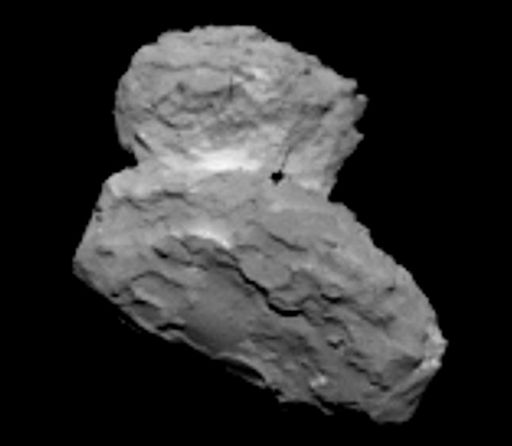 Astro Picture of the Day: August 3, 2014 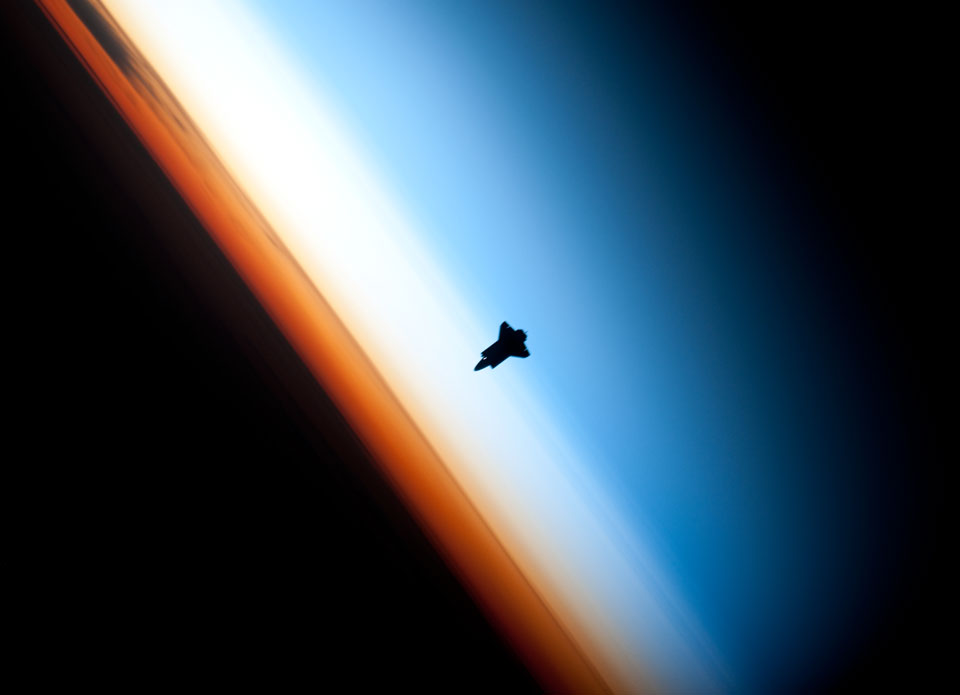 What's that approaching? Astronauts on board the International Space Station first saw it in early 2010 far in the distance. Soon it enlarged to become a dark silhouette. As it came even closer, the silhouette appeared to be a spaceship. Finally, the object revealed itself to be the Space Shuttle Endeavour, and it soon docked as expected with the Earth-orbiting space station. Pictured above, Endeavour was imaged near Earth's horizon as it approached, where several layers of the Earth's atmosphere were visible. Directly behind the shuttle is the mesosphere, which appears blue. The atmospheric layer that appears white is the stratosphere, while the orange layer is Earth's Troposphere. This shuttle mission, began with a dramatic night launch. Tasks completed during this shuttle's visit to the ISS included the delivery of the Tranquility Module which contained a cupola bay window complex that allows even better views of spaceships approaching and leaving the space station.
__________________
1st in Kommisar's 2009 SM Tournament 1st in I Love You`s 2009 New Year`s Tournament 3rd in EnR's Mashfest '08 tournament 5th in Phynx's Unofficial FFR Tournament 9th in D3 of the 2008-2009 4th Official FFR Tournament 10th in D5 of the 2010 5th Official FFR Tournament 10th in D6 of the 2011-2012 6th Official FFR Tournament FMO AAA Count: 71 FGO AAA Count: 10 Bluearrowll = The Canadian player who can not detect awkward patterns. If it's awkward for most people, it's normal for Terry. If the file is difficult but super straight forward, he has issues. If he's AAAing a FGO but then heard that his favorite Hockey team was losing by a point, Hockey > FFR PS: Cool AAA's Terry - I Love You An Alarm Clock's Haiku beep beep beep beep beep beep beep beep beep beep beep beep beep beep beep beep beep - ieatyourlvllol |
|
|

|
|
|
#1011 |
|
⊙▃⊙
|
Daily Suspicious0bserver's Weather Post:
August 4, 2014 What's in the sky tonight? August 4, 2014 -This weekend, Jupiter and Mercury are in conjunction. Don't bother looking because the meeting takes place in the noontime sky. What human eyes cannot see, however, spacecraft can. Using an opaque disk to block the glare of the sun, the Solar and Heliospheric Observatory (SOHO) is monitoring the encounter. At closest approach on August 2nd, the two bright planets were less than 1o apart. If such an alignment occured at night, it would surely be headline news. At noon, its just spaceweather news.  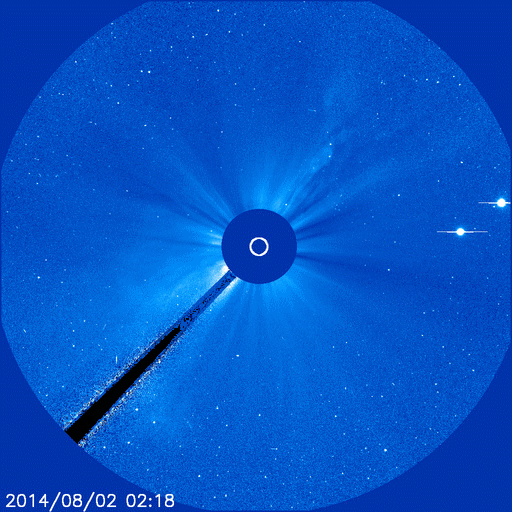 Astro Picture of the Day: August 4, 2014 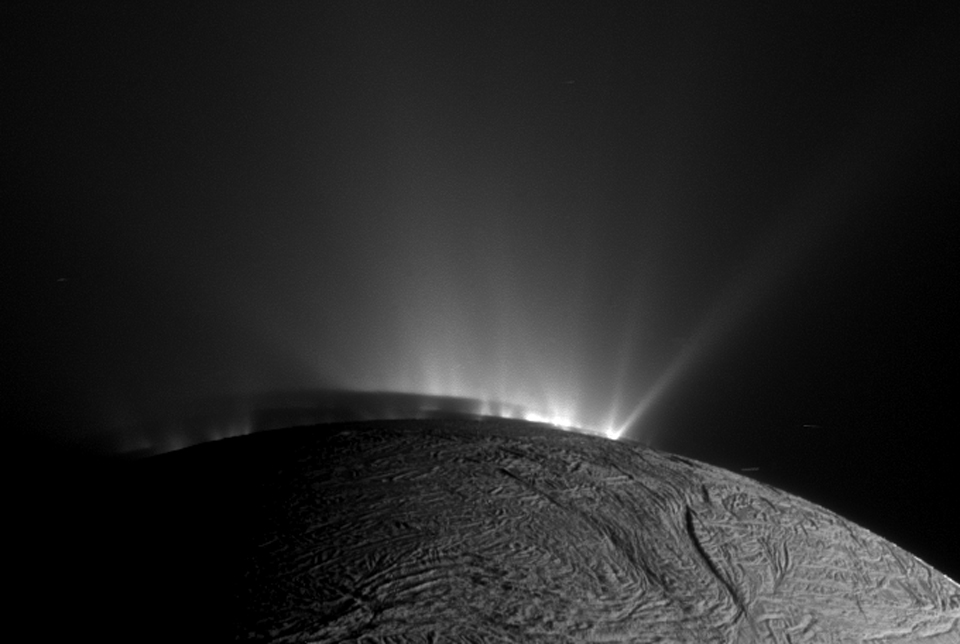 Why does Enceladus have ice plumes? The discovery of jets spewing water vapor and ice was detected by the Saturn-orbiting Cassini spacecraft in 2005. The origin of the water feeding the jets, however, remained a topic of research. A leading hypothesis held that the source might originate from a deep underground sea, but another hypothesis indicated that it might just be ice melted off walls of deep rifts by the moon's tidal flexing and heating. Pictured above, the textured surface of Enceladus is visible in the foreground, while rows of plumes rise from ice fractures in the distance. These jets are made more visible by the Sun angle and the encroaching shadow of night. Recent study of over a hundred images like this -- of geysers crossing Enceladus' South Pole, together with regional heat maps, indicate that these plumes likely originate from a hidden sea, incresaing the chance that this frosty globe might be harboring life.
__________________
1st in Kommisar's 2009 SM Tournament 1st in I Love You`s 2009 New Year`s Tournament 3rd in EnR's Mashfest '08 tournament 5th in Phynx's Unofficial FFR Tournament 9th in D3 of the 2008-2009 4th Official FFR Tournament 10th in D5 of the 2010 5th Official FFR Tournament 10th in D6 of the 2011-2012 6th Official FFR Tournament FMO AAA Count: 71 FGO AAA Count: 10 Bluearrowll = The Canadian player who can not detect awkward patterns. If it's awkward for most people, it's normal for Terry. If the file is difficult but super straight forward, he has issues. If he's AAAing a FGO but then heard that his favorite Hockey team was losing by a point, Hockey > FFR PS: Cool AAA's Terry - I Love You An Alarm Clock's Haiku beep beep beep beep beep beep beep beep beep beep beep beep beep beep beep beep beep - ieatyourlvllol |
|
|

|
|
|
#1012 |
|
⊙▃⊙
|
Daily Suspicious0bserver's Weather Post:
August 5, 2014 What's in the sky tonight? August 5, 2014 -Look below the Moon this evening for the red supergiant Antares, as shown at right. Around Antares and to its right are other stars of upper Scorpius. -Meteor activity is increasing as Earth plunges deeper into the debris stream of Comet Swift-Tuttle, source of the annual Perseid meteor shower. On the night of Aug 3-4, NASA cameras recorded more than a dozen Perseid fireballs over the USA. Counts are high even though the shower's peak is still more than a week away. To see for yourself, get away from city lights and look up during the dark hours before sunrise. -On Saturday night, August 2nd, NASA meteor cameras detected a fireball that exploded in a flash of light many times brighter than the Moon. It came not from the Perseid debris stream, but rather from the vicinity of the asteroid belt between Mars and Jupiter. "The meteoroid was about 15 inches in diameter and weighed close to 100 lbs," says Bill Cooke of NASA's Meteoroid Environment Office. "Travelling 47,000 miles per hour, it broke apart in a brilliant flash of light above the Alabama town of Henagar. Our cameras continued to track a large fragment until it disappeared 18 miles above Gaylesville, located near Lake Weiss close to the Georgia state line. At last sight, the fragment was still traveling at 11,000 miles per hour. Based on the meteor's speed, final altitude, and weak doppler radar signatures, we believe that this fireball produced small meteorites on the ground somewhere between Borden Springs, AL and Lake Weiss." The NASA Meteoroid Environment Office would like to hear from those in the area around Alabama's Lake Weiss who may have heard sonic booms or similar sounds around 10:20 PM Saturday night. Please contact Dr. Bill Cooke at william.j.cooke@nasa.gov with reports. Link to the movie: http://fireballs.ndc.nasa.gov/events...31914A_02A.avi  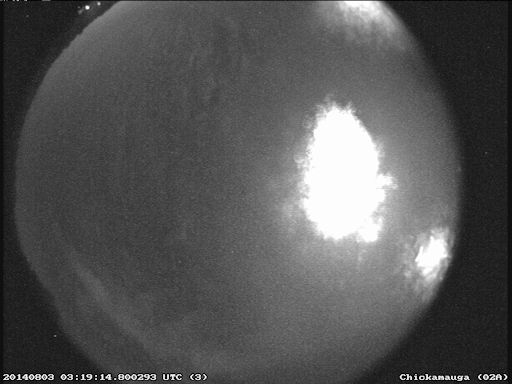 Astro Picture of the Day: August 5, 2014 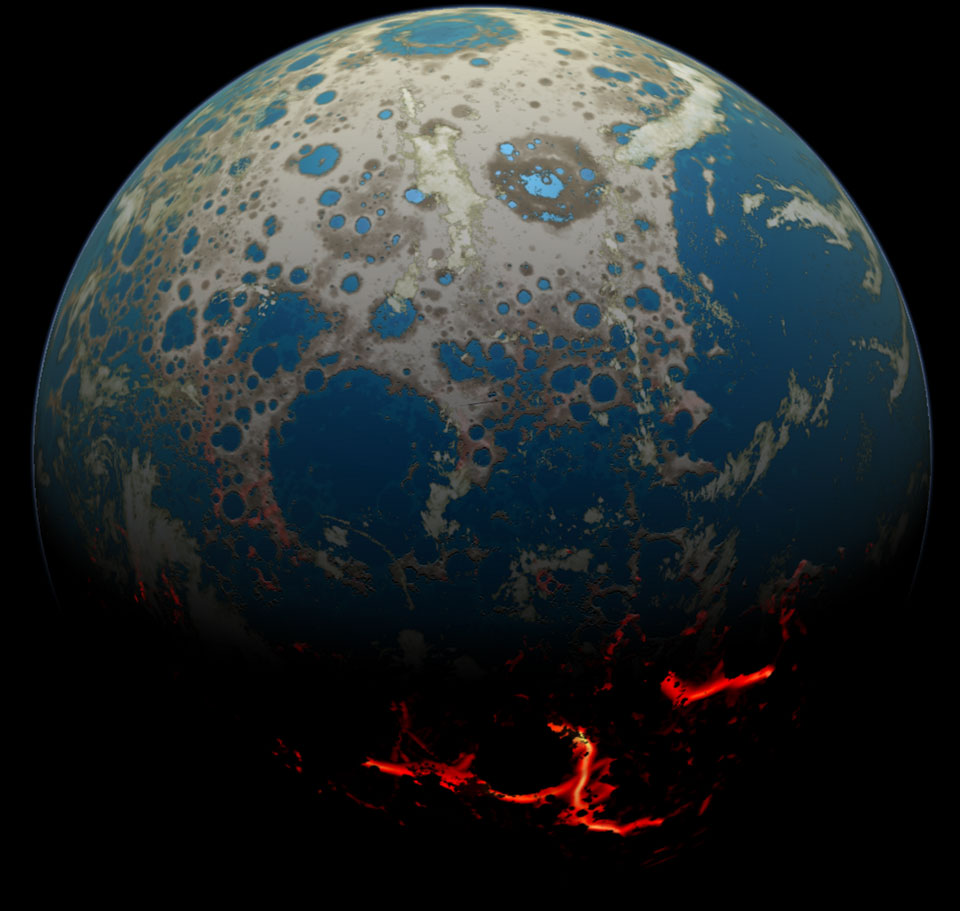 No place on Earth was safe. Four billion years ago, during the Hadean eon, our Solar System was a dangerous shooting gallery of large and dangerous rocks and ice chunks. Recent examination of lunar and Earth bombardment data indicate that the entire surface of the Earth underwent piecemeal upheavals, hiding our globe's ancient geologic history, and creating a battered world with no remaining familiar land masses. The rain of devastation made it difficult for any life to survive, although bacteria that could endure high temperatures had the best chance. Oceans thought to have formed during this epoch would boil away after particularly heavy impacts, only to reform again. The above artist's illustration depicts how Earth might have looked during this epoch, with circular impact features dotting the daylight side, and hot lava flows visible in the night. One billion years later, in a calmer Solar System, Earth's first supercontinent formed.
__________________
1st in Kommisar's 2009 SM Tournament 1st in I Love You`s 2009 New Year`s Tournament 3rd in EnR's Mashfest '08 tournament 5th in Phynx's Unofficial FFR Tournament 9th in D3 of the 2008-2009 4th Official FFR Tournament 10th in D5 of the 2010 5th Official FFR Tournament 10th in D6 of the 2011-2012 6th Official FFR Tournament FMO AAA Count: 71 FGO AAA Count: 10 Bluearrowll = The Canadian player who can not detect awkward patterns. If it's awkward for most people, it's normal for Terry. If the file is difficult but super straight forward, he has issues. If he's AAAing a FGO but then heard that his favorite Hockey team was losing by a point, Hockey > FFR PS: Cool AAA's Terry - I Love You An Alarm Clock's Haiku beep beep beep beep beep beep beep beep beep beep beep beep beep beep beep beep beep - ieatyourlvllol |
|
|

|
|
|
#1013 |
|
⊙▃⊙
|
Daily Suspicious0bserver's Weather Post:
August 6, 2014 What's in the sky tonight? August 6, 2014 -Antares is well to the lower right of the Moon this evening, as shown here. More than twice as far to the Moon's upper left shines Altair. -The European Space Agency's Rosetta probe has reached 67P/Churyumov-Gerasimenko and is maneuvering to go into orbit around the comet's core. This is an historic event. After Rosetta goes into orbit, it will follow the comet around the sun, observing its activity from point-blank range for more than a year. Moreover, in November, Rosetta will drop a lander onto the comet's strange surface. Today's events are being streamed live by the ESA. Link: http://sci.esa.int/rosetta/54457-ros...he-event-live/ -On Tuesday morning, August 5th, a SpaceX Falcon 9 rocket lifted off from Cape Canaveral carrying the AsiaSat 8 telecommunications satellite. About an hour and a half after the 4 AM launch, electric-blue clouds appeared over Orlando FL. "These clouds appeared just before sunrise," says photographer Mike Bartils. These are, essentially, man-made noctilucent clouds (NLCs). Water vapor in the exhaust of the rocket crystallized in the high atmosphere, creating an icy cloud that turned blue when it was hit by the rays of the morning sun. Years ago, space shuttle launches produced similar displays. Natural NLCs form around Earth's poles when water vapor in the mesosphere crystalizes around meteor smoke. Sometimes they spread as far south as Colorado and Utah, but rarely or never Florida. Electric-blue over the Sunshine State requires a rocket launch, and that's what happened today.  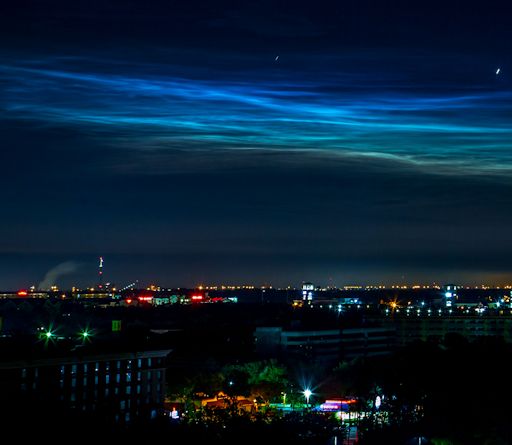 Astro Picture of the Day: August 6, 2014  Acquiring its first sunlit views of far northern Saturn in late 2012, the Cassini spacecraft's wide-angle camera recorded this stunning, false-color image of the ringed planet's north pole. The composite of near-infrared image data results in red hues for low clouds and green for high ones, giving the Saturnian cloudscape a vivid appearance. Enormous by terrestrial standards, Saturn's north polar hurricane-like storm is deep, red, and about 2,000 kilometers wide. Clouds at its outer edge travel at over 500 kilometers per hour. Other atmospheric vortices also swirl inside the large, yellowish green, six-sided jet stream known as the hexagon. Beyond the cloud tops at the upper right, arcs of the planet's eye-catching rings appear bright blue.
__________________
1st in Kommisar's 2009 SM Tournament 1st in I Love You`s 2009 New Year`s Tournament 3rd in EnR's Mashfest '08 tournament 5th in Phynx's Unofficial FFR Tournament 9th in D3 of the 2008-2009 4th Official FFR Tournament 10th in D5 of the 2010 5th Official FFR Tournament 10th in D6 of the 2011-2012 6th Official FFR Tournament FMO AAA Count: 71 FGO AAA Count: 10 Bluearrowll = The Canadian player who can not detect awkward patterns. If it's awkward for most people, it's normal for Terry. If the file is difficult but super straight forward, he has issues. If he's AAAing a FGO but then heard that his favorite Hockey team was losing by a point, Hockey > FFR PS: Cool AAA's Terry - I Love You An Alarm Clock's Haiku beep beep beep beep beep beep beep beep beep beep beep beep beep beep beep beep beep - ieatyourlvllol |
|
|

|
|
|
#1014 |
|
⊙▃⊙
|
Daily Suspicious0bserver's Weather Post:
August 7, 2014 What's in the sky tonight? August 7, 2014 -Vega is the brightest star very high in the east after dusk, almost overhead. The brightest in the southeast is Altair, nearly as bright. Altair is flagged by little Tarazed (3rd magnitude) a finger-width above it: an orange giant far in Altair's background. -For the first time ever, a spacecraft from Earth is traveling alongside a comet. Yesterday, at the end of a 10 year and 6 billion km journey, the European Space Agency's Rosetta probe reached 67P/Churyumov-Gerasimenko. On approach, Rosetta's OSIRIS camera took this stunning picture of the comet's nucleus only 130 km away. The image clearly shows a range of features including boulders, craters and steep cliffs. As the ESA science team noted this morning, "choosing a landing site will not be easy." More close-up shots may be found here. Rosetta has reached the comet, but it is not in orbit yet. As the below video shows, the spacecraft will spend the next month maneuvering closer and closer to the comet's core. When Rosetta dscends to within about 30 km of the surface in early September, the comet's weak gravity will be able to capture the spacecraft into a final orbit. 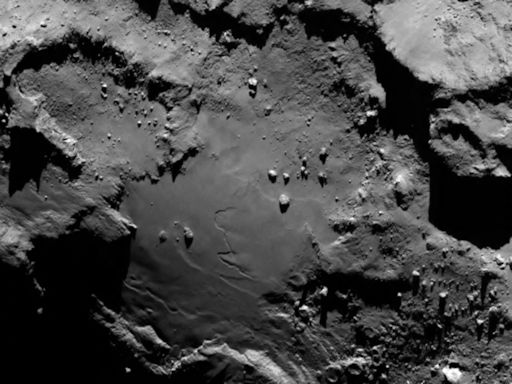 Astro Picture of the Day: August 7, 2014  On August 3rd, the Rosetta spacecraft's narrow angle camera captured this stunning image of the nucleus of Comet 67P/Churyumov-Gerasimenko. After 10 years and 6.5 billion kilometers of travel along gravity assist trajectories looping through interplanetary space, Rosetta had approached to within 285 kilometers of its target. The curious double-lobed shape of the nucleus is revealed in amazing detail at an image resolution of 5.3 meters per pixel. About 4 kilometers across, the comet nucleus is presently just over 400 million kilometers from Earth, between the orbits of Jupiter and Mars. Now the first spacecraft to achieve a delicate orbit around a comet, Rosetta will swing to within 50 kilometers and closer in the coming weeks, identifiying candidate sites for landing its probe Philae later this year.
__________________
1st in Kommisar's 2009 SM Tournament 1st in I Love You`s 2009 New Year`s Tournament 3rd in EnR's Mashfest '08 tournament 5th in Phynx's Unofficial FFR Tournament 9th in D3 of the 2008-2009 4th Official FFR Tournament 10th in D5 of the 2010 5th Official FFR Tournament 10th in D6 of the 2011-2012 6th Official FFR Tournament FMO AAA Count: 71 FGO AAA Count: 10 Bluearrowll = The Canadian player who can not detect awkward patterns. If it's awkward for most people, it's normal for Terry. If the file is difficult but super straight forward, he has issues. If he's AAAing a FGO but then heard that his favorite Hockey team was losing by a point, Hockey > FFR PS: Cool AAA's Terry - I Love You An Alarm Clock's Haiku beep beep beep beep beep beep beep beep beep beep beep beep beep beep beep beep beep - ieatyourlvllol |
|
|

|
|
|
#1015 |
|
⊙▃⊙
|
Daily Suspicious0bserver's Weather Post:
August 8, 2014 What's in the sky tonight? August 8, 2014 -Already you may see an occasional Perseid meteor if you keep an eye on the night sky. The shower's peak night is predicted for next Tuesday (August 12–13), but moonlight will compromise the view all week. Look northeast as the stars come out for W-shaped Cassiopeia. It's still not quite as high as the Big Dipper is in the northwest, but the two are on their way to their dusk balance point week by week. Get a preview of this by checking on them around 11 p.m. (depending on your location). -This Friday, Aug. 8th, the students of Earth to Sky Calculus will continue their ongoing campaign of high-altitude research with the launch of another Space Weather Radiation Buoy. The purpose of the research is to discover how solar activity affects the ozone layer and alters levels of radiation at altitudes of interest to aviation and space tourism. Astro Picture of the Day: August 8, 2014 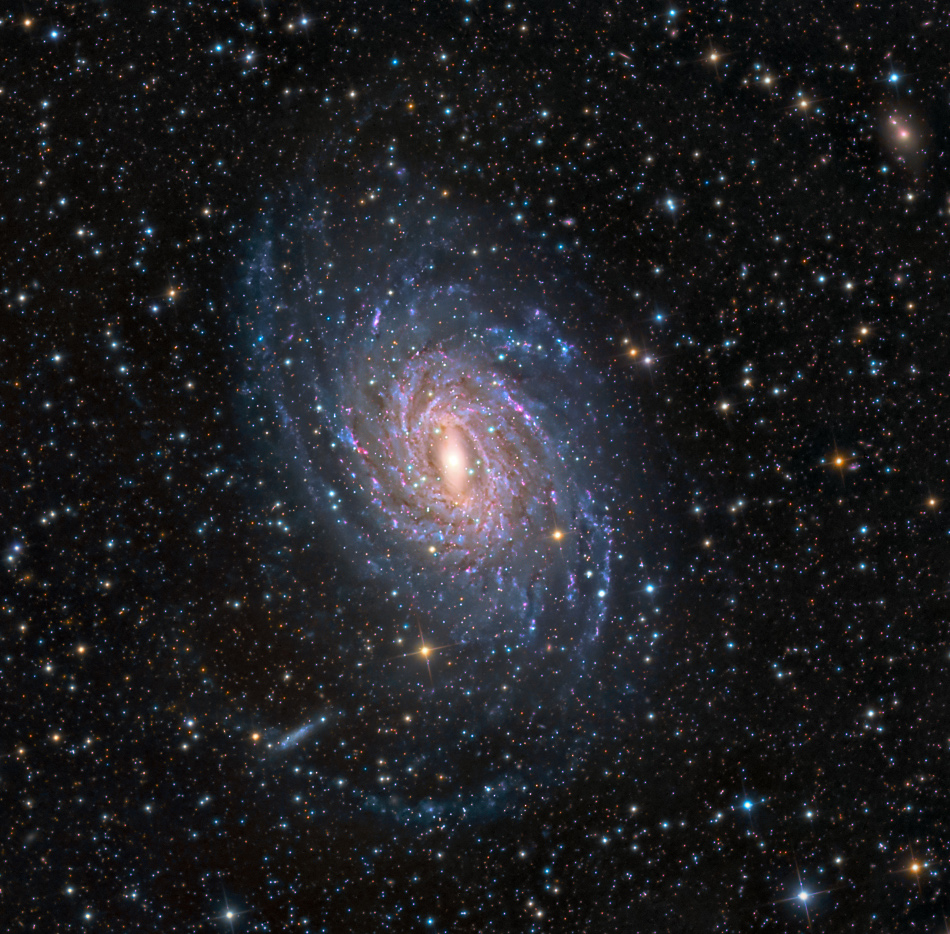 Big, beautiful spiral galaxy NGC 6744 is nearly 175,000 light-years across, larger than our own Milky Way. It lies some 30 million light-years distant in the southern constellation Pavo. We see the disk of the nearby island universe tilted towards our line of sight. Orientation and composition give a strong sense of depth to this colorful galaxy portrait that covers an area about the angular size of the full moon. This giant galaxy's yellowish core is dominated by the light from old, cool stars. Beyond the core, spiral arms filled with young blue star clusters and pinkish star forming regions sweep past a smaller satellite galaxy at the lower left, reminiscent of the Milky Way's satellite galaxy the Large Magellanic Cloud.
__________________
1st in Kommisar's 2009 SM Tournament 1st in I Love You`s 2009 New Year`s Tournament 3rd in EnR's Mashfest '08 tournament 5th in Phynx's Unofficial FFR Tournament 9th in D3 of the 2008-2009 4th Official FFR Tournament 10th in D5 of the 2010 5th Official FFR Tournament 10th in D6 of the 2011-2012 6th Official FFR Tournament FMO AAA Count: 71 FGO AAA Count: 10 Bluearrowll = The Canadian player who can not detect awkward patterns. If it's awkward for most people, it's normal for Terry. If the file is difficult but super straight forward, he has issues. If he's AAAing a FGO but then heard that his favorite Hockey team was losing by a point, Hockey > FFR PS: Cool AAA's Terry - I Love You An Alarm Clock's Haiku beep beep beep beep beep beep beep beep beep beep beep beep beep beep beep beep beep - ieatyourlvllol |
|
|

|
|
|
#1016 |
|
⊙▃⊙
|
Daily Suspicious0bserver's Weather Post:
August 9, 2014 What's in the sky tonight? August 9, 2014 -If you're in the Earth's mid-northern latitudes, bright Vega passes close by your zenith around 10 or 11 p.m. (depending on where you live east-west in your time zone). Wherever you are, Deneb always passes the zenith two hours after Vega. -Sunspot AR2135 has a 'beta-gamma' magnetic field that harbors energy for M-class solar flares. Like every other sunspot that has crossed the solar disk in the past month, however, AR2135 seems reluctant to erupt. Solar activity is low and will likely remain so for the rest of the weekend. -On Friday, August 8th, Europe's robotic cargo carrier, the "George Lemaitre," flew just 4 miles underneath the International Space Station. In Berlin, Germany, astrophotographer Thomas Becker recorded the close encounter. "I caught the two spacecraft over the Wilhelm-Foerster-Observatory in Berlin," says Becker. "Bright moonlight completed the scenery." Loaded with more than seven tons of fuel and supplies, the George Lemaitre (a.k.a. "ATV-5") is scheduled to dock with the ISS on Tuesday, Aug. 12th. Friday's preliminary flyby allowed mission controllers to test a suite of lasers and sensors that may be incorporated into the design of future European spacecraft. George Lemaitre, the man, was a 20th century Belgian astronomer and physicist credited with proposing the theory of the expansion of the universe. ATV-5, the fifth in Europe's series of Automated Transfer Vehicles for shuttling supplies to the ISS, was named in his honor. Track when the ISS will orbit over your head with http://heavens-above.com/ 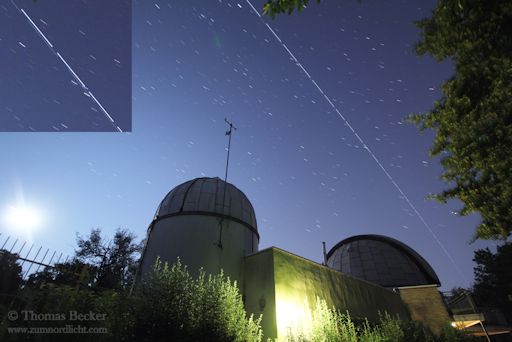 Astro Picture of the Day: August 9, 2014 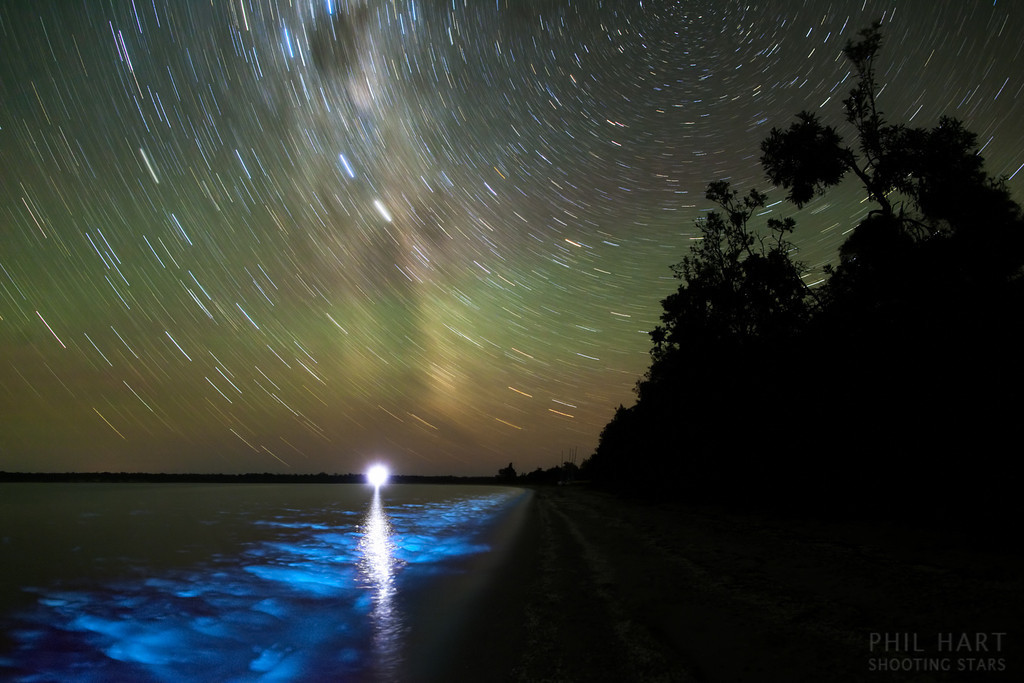 What shines in the world at night? Just visible to the eye, a rare electric blue glow spread along the shores of Victoria Lake on January 16, 2013. Against reflections of a light near the horizon, this digitally stacked long exposure recorded the bioluminescence of noctiluca scintillans, plankton stimulated by the lapping waves. Above, the night skies of the Gippsland Lakes region, Victoria, Australia shine with a fainter greenish airglow. Oxygen atoms in the upper atmosphere, initially excited by ultraviolet sunlight, produce the more widely seen fading atmospheric chemiluminescence. Washed out by the Earth's rotation, the faint band of the southern summer Milky Way stretches from the horizon as star trails circle the South Celestial Pole.
__________________
1st in Kommisar's 2009 SM Tournament 1st in I Love You`s 2009 New Year`s Tournament 3rd in EnR's Mashfest '08 tournament 5th in Phynx's Unofficial FFR Tournament 9th in D3 of the 2008-2009 4th Official FFR Tournament 10th in D5 of the 2010 5th Official FFR Tournament 10th in D6 of the 2011-2012 6th Official FFR Tournament FMO AAA Count: 71 FGO AAA Count: 10 Bluearrowll = The Canadian player who can not detect awkward patterns. If it's awkward for most people, it's normal for Terry. If the file is difficult but super straight forward, he has issues. If he's AAAing a FGO but then heard that his favorite Hockey team was losing by a point, Hockey > FFR PS: Cool AAA's Terry - I Love You An Alarm Clock's Haiku beep beep beep beep beep beep beep beep beep beep beep beep beep beep beep beep beep - ieatyourlvllol |
|
|

|
|
|
#1017 |
|
⊙▃⊙
|
Daily Suspicious0bserver's Weather Post:
August 10, 2014 What's in the sky tonight? August 10, 2014 -Largest full Moon of the year, but not by much. Can you really detect any difference? The Moon is only 8% larger than average. -As the one-month anniversary of the "All-Quiet Event" approaches, the sun's global X-ray output is sinking again. Solar activity is very low. Only one sunspot (AR2135) poses a threat for significant flares, but it seems reluctant to erupt. -Tonight's full Moon is the biggest and brightest full Moon of the year. Astronomers call it a perigee moon; the popular term is "supermoon." Stephen Mudge photographed the bright orb rising over the Mormon temple in Brisbane, Queensland, on Aug. 10th. Supermoons are possible because the Moon's orbit is not a circle, it is an ellipse. One side, perigee, is 50,000 km closer than the other, apogee. Today the Moon becomes full just as it reaches perigee, the point closest to Earth. The perigee supermoon you see tonight is as much as 14% closer and 30% brighter than other full Moons of the year. Go outside at sunset, look east, and enjoy the super-moonlight! 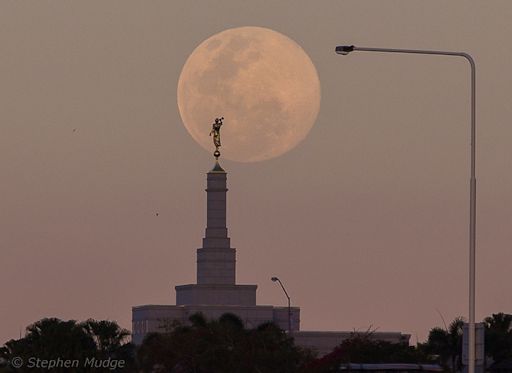 Astro Picture of the Day: August 10, 2014 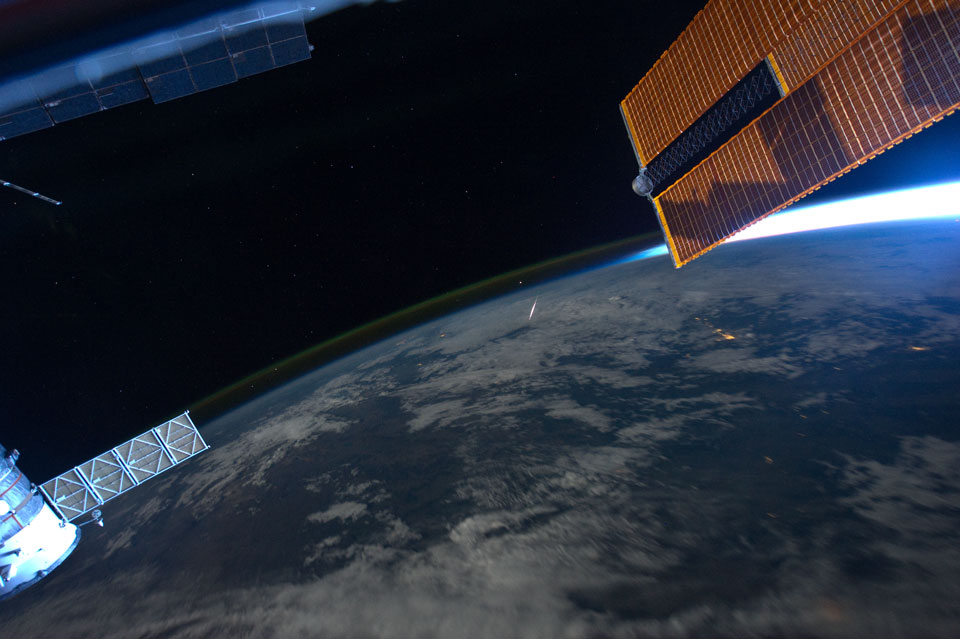 Denizens of planet Earth typically watch meteor showers by looking up. But this remarkable view, captured on August 13, 2011 by astronaut Ron Garan, caught a Perseid meteor by looking down. From Garan's perspective onboard the International Space Station orbiting at an altitude of about 380 kilometers, the Perseid meteors streak below, swept up dust left from comet Swift-Tuttle heated to incandescence. The glowing comet dust grains are traveling at about 60 kilometers per second through the denser atmosphere around 100 kilometers above Earth's surface. In this case, the foreshortened meteor flash is right of frame center, below the curving limb of the Earth and a layer of greenish airglow, just below bright star Arcturus. Want to look up at a meteor shower? You're in luck, as the 2014 Perseids meteor shower peaks this week. Unfortunately, the fainter meteors in this year's shower will be hard to see in a relatively bright sky lit by the glow of a nearly full Moon.
__________________
1st in Kommisar's 2009 SM Tournament 1st in I Love You`s 2009 New Year`s Tournament 3rd in EnR's Mashfest '08 tournament 5th in Phynx's Unofficial FFR Tournament 9th in D3 of the 2008-2009 4th Official FFR Tournament 10th in D5 of the 2010 5th Official FFR Tournament 10th in D6 of the 2011-2012 6th Official FFR Tournament FMO AAA Count: 71 FGO AAA Count: 10 Bluearrowll = The Canadian player who can not detect awkward patterns. If it's awkward for most people, it's normal for Terry. If the file is difficult but super straight forward, he has issues. If he's AAAing a FGO but then heard that his favorite Hockey team was losing by a point, Hockey > FFR PS: Cool AAA's Terry - I Love You An Alarm Clock's Haiku beep beep beep beep beep beep beep beep beep beep beep beep beep beep beep beep beep - ieatyourlvllol Last edited by Bluearrowll; 08-11-2014 at 06:04 AM.. |
|
|

|
|
|
#1018 |
|
⊙▃⊙
|
Daily Suspicious0bserver's Weather Post:
August 11, 2014 What's in the sky tonight? August 11, 2014 -Mars is pulling a little closer to Saturn every day. Spot them in the southwest at dusk; Mars is the one on the lower right. Tonight they're still 8° apart. Look farther to the lower right of Mars for twinkly Spica. -The full Moon of August 10th was as much as 14% bigger and 30% brighter than other full Moons of the year. Some say that makes it a supermoon. Others retort that it's really not as super as the media has made it out to be. Who's correct? Vesa Vauhkonen of Rautalampi, Finland, took a stab at settling the question with this side-by-side comparison. "I compared the normal full Moon of March 2014 with the Supermoon of Aug 2014," says Vauhkonen. "In individual images, the difference in size might be difficult to see, but putting them side by side makes the difference clear. I used the same photo settings for both images, so the scaling has no errors." Supermoons are possible because the Moon's orbit is not a circle, it is an ellipse. One side, perigee, is 50,000 km closer than the other, apogee. On August 10th the Moon became full just as it reached perigee, the point closest to Earth. This caused the Moon to appear authentically bigger and brighter than usual.  Astro Picture of the Day: August 11, 2014 What does it look like to approach a comet? Early this month humanity received a new rendition as the robotic Rosetta spacecraft went right up to -- and began orbiting -- the nucleus of Comet 67P/Churyumov-Gerasimenko. This approach turned out to be particularly fascinating because the comet nucleus first revealed itself to have an unexpected double structure, and later showed off an unusual and craggily surface. The above 101-frame time-lapse video details the approach of the spacecraft from August 1 through August 6. The icy comet's core is the size of a mountain and rotates every 12.7 hours. Rosetta's images and data may shed light on the origin of comets and the early history of our Solar System. Later this year, Rosetta is scheduled to release the Philae lander, which will attempt to land on Comet Churyumov–Gerasimenko's periphery and harpoon itself to the surface.
__________________
1st in Kommisar's 2009 SM Tournament 1st in I Love You`s 2009 New Year`s Tournament 3rd in EnR's Mashfest '08 tournament 5th in Phynx's Unofficial FFR Tournament 9th in D3 of the 2008-2009 4th Official FFR Tournament 10th in D5 of the 2010 5th Official FFR Tournament 10th in D6 of the 2011-2012 6th Official FFR Tournament FMO AAA Count: 71 FGO AAA Count: 10 Bluearrowll = The Canadian player who can not detect awkward patterns. If it's awkward for most people, it's normal for Terry. If the file is difficult but super straight forward, he has issues. If he's AAAing a FGO but then heard that his favorite Hockey team was losing by a point, Hockey > FFR PS: Cool AAA's Terry - I Love You An Alarm Clock's Haiku beep beep beep beep beep beep beep beep beep beep beep beep beep beep beep beep beep - ieatyourlvllol |
|
|

|
|
|
#1019 |
|
⊙▃⊙
|
Daily Suspicious0bserver's Weather Post:
August 12, 2014 What's in the sky tonight? August 12, 2014 -Peak Perseid meteor night late tonight. But the Moon, just two days after full, compromises the view. -The annual Perseid meteor shower peaks tonight, Aug. 12-13, as Earth passes through a stream of debris from Comet Swift-Tuttle. Forecasters expect peak rates of 30 to 40 meteors per hour, less than usual because of the glare from the waning supermoon. Observing tips: To reduce the effects of moonlight, pick an observing site with clear, dry air. Also try watching the sky from the moonshadow of a tall building or other obstacle. Many Perseid fireballs will be visible in spite of the glare. [NASA chat] Unaffected by moonlight, the Canadian Meteor Orbit Radar (CMOR) is scanning the skies above North America for echoes from disintegrating meteoroids. The latest CMOR sky map shows strong activity from the constellation Perseus (PER). The Perseids are not alone. In the southern hemisphere, a cluster of lesser radiants is also active. Foremost among them is the Southern Delta Aquarids (SDA) probably caused by debris from Comet 96P/Machholz. Delta Aquarid fireballs will augment the Perseids south of the equator.  Astro Picture of the Day: August 12, 2014 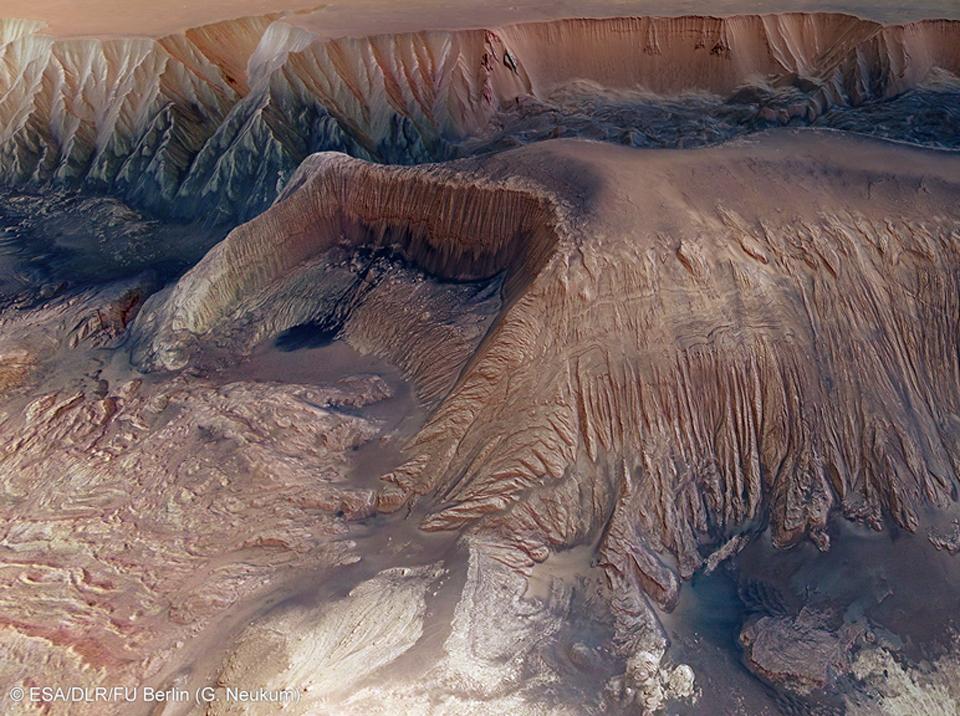 What's happened in Hebes Chasma on Mars? Hebes Chasma is a depression just north of the enormous Valles Marineris canyon. Since the depression is unconnected to other surface features, it is unclear where the internal material went. Inside Hebes Chasma is Hebes Mensa, a 5 kilometer high mesa that appears to have undergone an unusual partial collapse -- a collapse that might be providing clues. The above image, taken by the robotic Mars Express spacecraft currently orbiting Mars, shows great details of the chasm and the unusual horseshoe shaped indentation in the central mesa. Material from the mesa appears to have flowed onto the floor of the chasm, while a possible dark layer appears to have pooled like ink on a downslope landing. A recent hypothesis holds that salty rock composes some lower layers in Hebes Chasma, with the salt dissolving in melted ice flows that drained through holes into an underground aquifer.
__________________
1st in Kommisar's 2009 SM Tournament 1st in I Love You`s 2009 New Year`s Tournament 3rd in EnR's Mashfest '08 tournament 5th in Phynx's Unofficial FFR Tournament 9th in D3 of the 2008-2009 4th Official FFR Tournament 10th in D5 of the 2010 5th Official FFR Tournament 10th in D6 of the 2011-2012 6th Official FFR Tournament FMO AAA Count: 71 FGO AAA Count: 10 Bluearrowll = The Canadian player who can not detect awkward patterns. If it's awkward for most people, it's normal for Terry. If the file is difficult but super straight forward, he has issues. If he's AAAing a FGO but then heard that his favorite Hockey team was losing by a point, Hockey > FFR PS: Cool AAA's Terry - I Love You An Alarm Clock's Haiku beep beep beep beep beep beep beep beep beep beep beep beep beep beep beep beep beep - ieatyourlvllol |
|
|

|
|
|
#1020 |
|
⊙▃⊙
|
Daily Suspicious0bserver's Weather Post:
August 13, 2014 What's in the sky tonight? August 13, 2014 -The waning gibbous Moon rises in the east just about at the end of twilight. Look above the Moon (or above where it's just about to rise) for the Great Square of Pegasus, larger than your fist at arm's length and standing on one corner. -Comet Siding Spring is about to fly historically close to Mars. The encounter could spark Martian auroras, a meteor shower, and other unpredictable effects. Whatever happens, NASA's fleet of Mars satellites will have a ringside seat. Astro Picture of the Day: August 13, 2014 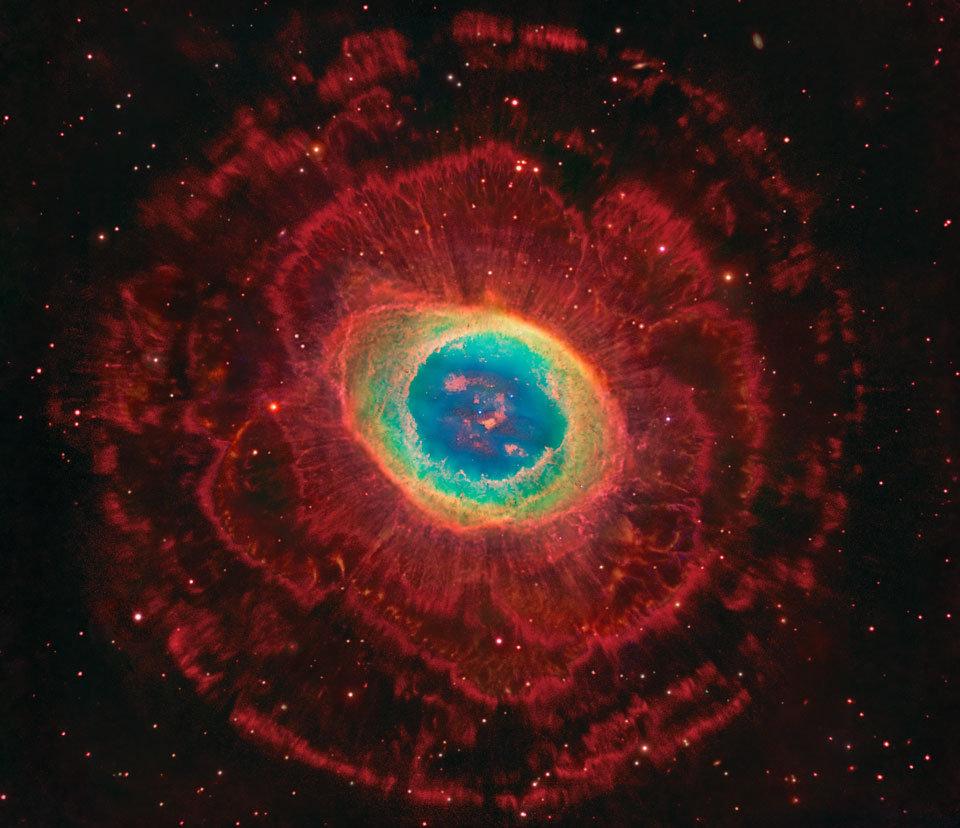 It is a familiar sight to sky enthusiasts with even a small telescope. There is much more to the Ring Nebula (M57), however, than can be seen through a small telescope. The easily visible central ring is about one light-year across, but this remarkably deep exposure - a collaborative effort combining data from three different large telescopes - explores the looping filaments of glowing gas extending much farther from the nebula's central star. This remarkable composite image includes narrowband hydrogen image, visible light emission, and infrared light emission. Of course, in this well-studied example of a planetary nebula, the glowing material does not come from planets. Instead, the gaseous shroud represents outer layers expelled from a dying, sun-like star. The Ring Nebula is about 2,000 light-years away toward the musical constellation Lyra.
__________________
1st in Kommisar's 2009 SM Tournament 1st in I Love You`s 2009 New Year`s Tournament 3rd in EnR's Mashfest '08 tournament 5th in Phynx's Unofficial FFR Tournament 9th in D3 of the 2008-2009 4th Official FFR Tournament 10th in D5 of the 2010 5th Official FFR Tournament 10th in D6 of the 2011-2012 6th Official FFR Tournament FMO AAA Count: 71 FGO AAA Count: 10 Bluearrowll = The Canadian player who can not detect awkward patterns. If it's awkward for most people, it's normal for Terry. If the file is difficult but super straight forward, he has issues. If he's AAAing a FGO but then heard that his favorite Hockey team was losing by a point, Hockey > FFR PS: Cool AAA's Terry - I Love You An Alarm Clock's Haiku beep beep beep beep beep beep beep beep beep beep beep beep beep beep beep beep beep - ieatyourlvllol |
|
|

|
 |
| Currently Active Users Viewing This Thread: 1 (0 members and 1 guests) | |
|
|